SKODA ROOMSTER 2013 1.G Owner's Manual
Manufacturer: SKODA, Model Year: 2013, Model line: ROOMSTER, Model: SKODA ROOMSTER 2013 1.GPages: 219, PDF Size: 13.83 MB
Page 141 of 219
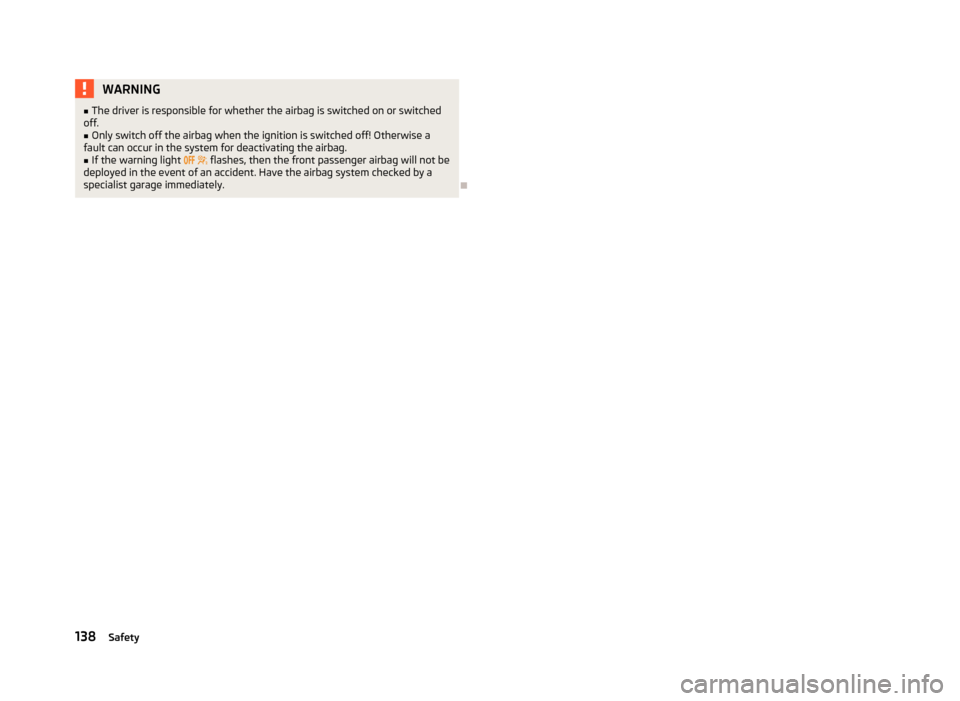
WARNING■The driver is responsible for whether the airbag is switched on or switched
off.■
Only switch off the airbag when the ignition is switched off! Otherwise a
fault can occur in the system for deactivating the airbag.
■
If the warning light flashes, then the front passenger airbag will not be
deployed in the event of an accident. Have the airbag system checked by a
specialist garage immediately.
138Safety
Page 142 of 219
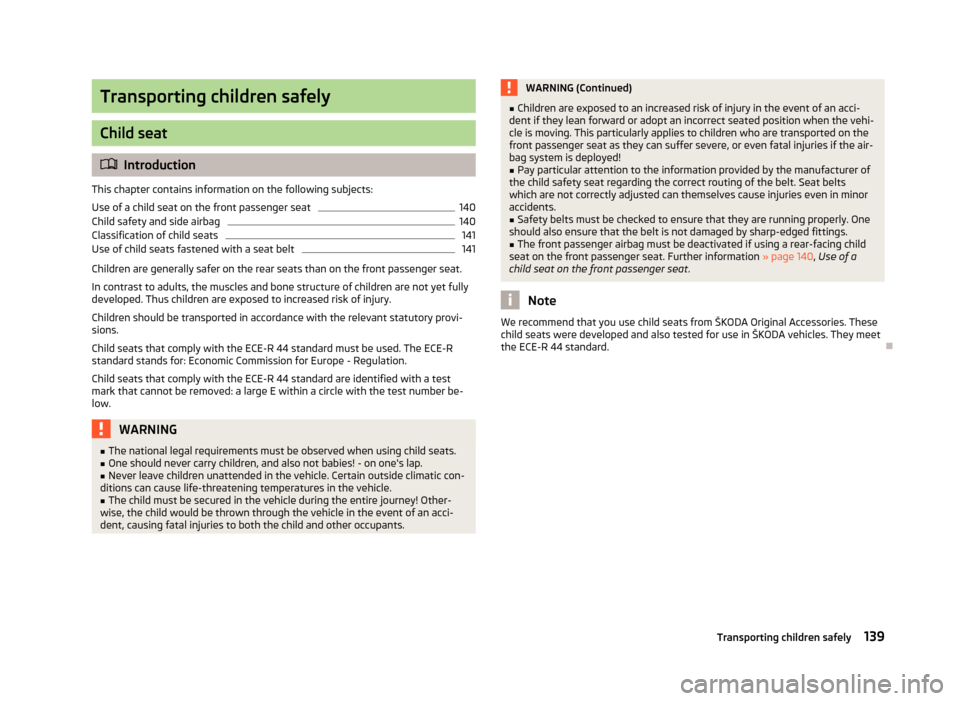
Transporting children safely
Child seat
Introduction
This chapter contains information on the following subjects:
Use of a child seat on the front passenger seat
140
Child safety and side airbag
140
Classification of child seats
141
Use of child seats fastened with a seat belt
141
Children are generally safer on the rear seats than on the front passenger seat.
In contrast to adults, the muscles and bone structure of children are not yet fully developed. Thus children are exposed to increased risk of injury.
Children should be transported in accordance with the relevant statutory provi-sions.
Child seats that comply with the ECE-R 44 standard must be used. The ECE-R
standard stands for: Economic Commission for Europe - Regulation.
Child seats that comply with the ECE-R 44 standard are identified with a test
mark that cannot be removed: a large E within a circle with the test number be-
low.
WARNING■ The national legal requirements must be observed when using child seats.■One should never carry children, and also not babies! - on one's lap.■
Never leave children unattended in the vehicle. Certain outside climatic con-
ditions can cause life-threatening temperatures in the vehicle.
■
The child must be secured in the vehicle during the entire journey! Other-
wise, the child would be thrown through the vehicle in the event of an acci-
dent, causing fatal injuries to both the child and other occupants.
WARNING (Continued)■ Children are exposed to an increased risk of injury in the event of an acci-
dent if they lean forward or adopt an incorrect seated position when the vehi-
cle is moving. This particularly applies to children who are transported on the
front passenger seat as they can suffer severe, or even fatal injuries if the air-
bag system is deployed!■
Pay particular attention to the information provided by the manufacturer of
the child safety seat regarding the correct routing of the belt. Seat belts which are not correctly adjusted can themselves cause injuries even in minor
accidents.
■
Safety belts must be checked to ensure that they are running properly. One
should also ensure that the belt is not damaged by sharp-edged fittings.
■
The front passenger airbag must be deactivated if using a rear-facing child
seat on the front passenger seat. Further information » page 140, Use of a
child seat on the front passenger seat .
Note
We recommend that you use child seats from ŠKODA Original Accessories. These
child seats were developed and also tested for use in ŠKODA vehicles. They meet
the ECE-R 44 standard.
139Transporting children safely
Page 143 of 219

Use of a child seat on the front passenger seat
Never use a backwards-facing child restraint system on a seat that is protected by an active airbag installed in front of it. This could cause the child severe injury
or even death.Fig. 120
Sticker on the B column on the
front passenger side.
First read and observe the introductory information and safety warn- ings on page 139.
For safety reasons, we recommend that you install child seats on the rear seats
whenever possible.
The following instructions must be followed when using a child seat on the front passenger seat.
› The front passenger airbag must be deactivated if using a rear-facing child
seat »
.
› If possible, adjust the front passenger seat backrest so that it is as vertical, so
as to ensure secure contact between the passenger seat backrest and the back
of the child seat.
› If possible, move the front passenger seat backwards so that there is no con-
tact between the front passenger seat and the child seat behind it.
› With child safety seats in groups 2 or 3, make sure that the loop-around fittings
attached to the child seat headrest is positioned in front of or at the same
height as the loop-around fittings on the B pillar on the passenger side.
› Set the height-adjustable front passenger seat as high up as possible.
› Set the front passenger seat belt as high up as possible.
› Place and fasten the child seat on the seat and the child in the child seat ac-
cording to the specifications in the manufacturer's user manual of the child seat .
WARNING■ The front passenger airbag must be deactivated if using a rear-facing child
seat on the front passenger seat » page 136, Deactivating airbags .■
Never use a rear-facing child seat on the front passenger seat if the passen-
ger airbag is activated. This child safety seat is positioned in the deployment
area of the front passenger airbag. The airbag may cause the child severe, or
even fatal injuries, in the event of it being deployed.
■
This is also clearly stated on the sticker which is located on the B pillar on
the passenger side » Fig. 120. The sticker is visible upon opening the front
passenger door. In some countries, the sticker is affixed to the front passen-
ger sun visor.
■
With child safety seats in groups 2 or 3, make sure that the loop-around fit-
tings attached to the child seat headrest is positioned in front of or at the
same height as the loop-around fittings on the B pillar on the passenger side.
■
As soon as the rear-facing child seat is no longer being used on the passen-
ger seat, the front passenger airbag should be re-activated again.
Child safety and side airbag
Fig. 121
Incorrect seated position of a child who is not properly secured –
risk from the side airbag/child properly protected by child seat
First read and observe the introductory information and safety warn-
ings
on page 139.
The child must not be positioned in the area into which the side airbag will de-
ploy » Fig. 121 -
.
140Safety
Page 144 of 219
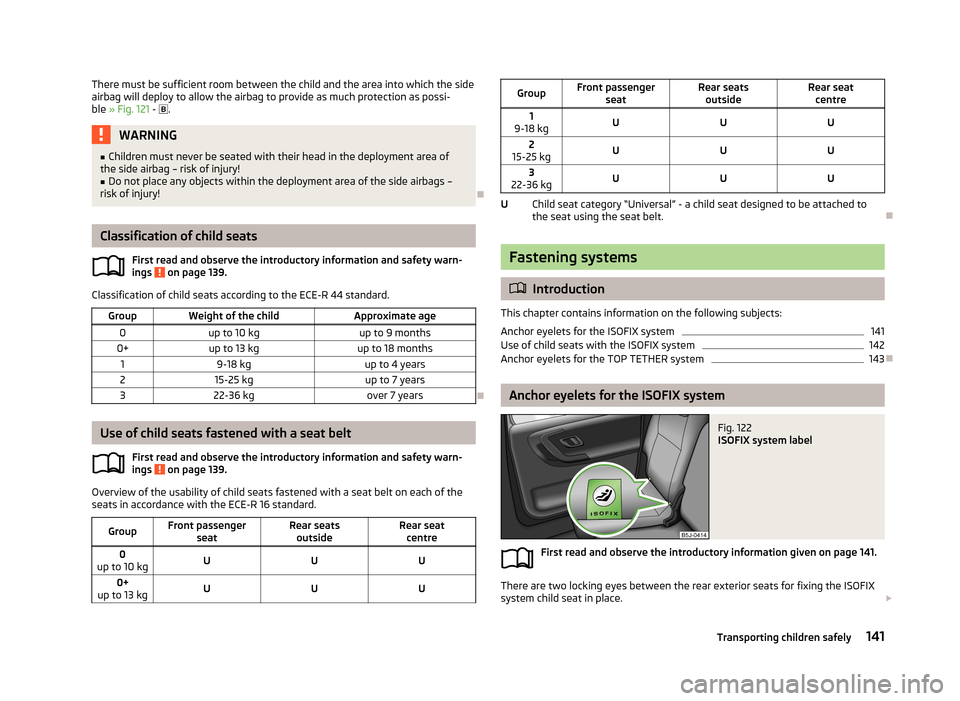
There must be sufficient room between the child and the area into which the side
airbag will deploy to allow the airbag to provide as much protection as possi-
ble » Fig. 121 - .WARNING■
Children must never be seated with their head in the deployment area of
the side airbag – risk of injury!■
Do not place any objects within the deployment area of the side airbags –
risk of injury!
Classification of child seats
First read and observe the introductory information and safety warn-
ings
on page 139.
Classification of child seats according to the ECE-R 44 standard.
GroupWeight of the childApproximate age0up to 10 kgup to 9 months0+up to 13 kgup to 18 months19-18 kgup to 4 years215-25 kgup to 7 years322-36 kgover 7 years
Use of child seats fastened with a seat belt
First read and observe the introductory information and safety warn-ings
on page 139.
Overview of the usability of child seats fastened with a seat belt on each of theseats in accordance with the ECE-R 16 standard.
GroupFront passenger
seatRear seatsoutsideRear seat centre0
up to 10 kgUUU0+
up to 13 kgUUUGroupFront passenger seatRear seatsoutsideRear seat centre1
9-18 kgUUU2
15-25 kgUUU3
22-36 kgUUU
Child seat category “Universal” - a child seat designed to be attached to the seat using the seat belt.
Fastening systems
Introduction
This chapter contains information on the following subjects:
Anchor eyelets for the ISOFIX system
141
Use of child seats with the ISOFIX system
142
Anchor eyelets for the TOP TETHER system
143
Anchor eyelets for the ISOFIX system
Fig. 122
ISOFIX system label
First read and observe the introductory information given on page 141.
There are two locking eyes between the rear exterior seats for fixing the ISOFIX
system child seat in place.
U141Transporting children safely
Page 145 of 219

The places are marked with labels with the ISOFIX logo » Fig. 122.WARNING■
Always refer to the instructions from the manufacturer of the child seat
when installing and removing a child seat with the ISOFIX system.■
Never attach other child seats, belts or objects to the anchor eyelets inten-
ded for the installation of a child seat with the ISOFIX system – risk to life!
Note■ A child seat fitted with the ISOFIX system can only be mounted in a vehicle fit-
ted with an ISOFIX system if the child seat has been approved for this type of ve-
hicle. Further information is available from a ŠKODA Partner.■
Child seats with the ISOFIX system can be purchased from ŠKODA Original Ac-
cessories.
Use of child seats with the ISOFIX system
First read and observe the introductory information given on page 141.
Overview of the usability of child seats with the ISOFIX system on each of the
seats in accordance with the ECE-R 16 standard.
GroupSize class
of the child seat a)Front passenger seat b)Outer rear seatsRear seat middle0
up to 10 kgEXIL-SUX0+
up to 13 kgE
XIL-SUX
DC
1
9-18 kg
D
XIL-SU IUFX
CBB1Aa)
The size category is shown on the label attached to the child seat.
b)
If the front passenger seat is fitted with the ISOFIX system attachment points, it is suited for the installation of an ISOFIX child seat with the “Semi-Universal” approval.
The seat is suited for installation of an ISOFIX child seat with “Semi-
Universal” approval. The category “Semi-Universal” means that the child seat with the ISOFIX system is approved for your vehicle. Observe the list
of vehicles that comes with the child seat.
The seat is suitable for the installation of an ISOFIX child seat with
“Universal” approval and attachment with the TOP TETHER belt.
The seat is not fitted with fixing eyes for the ISOFIX system.IL-SUIUFX142Safety
Page 146 of 219
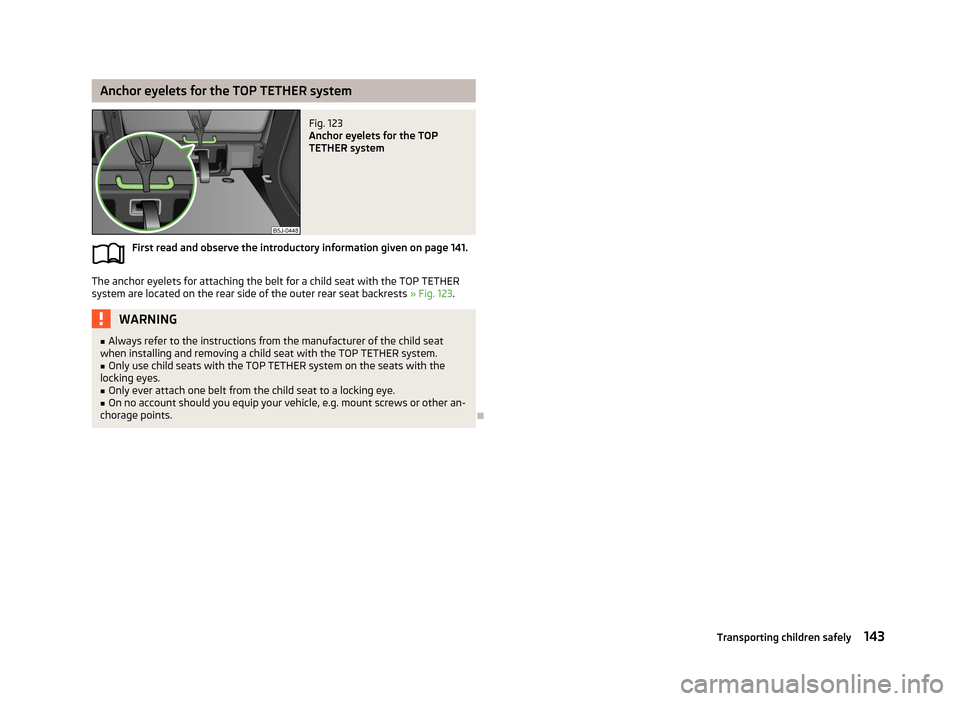
Anchor eyelets for the TOP TETHER systemFig. 123
Anchor eyelets for the TOP
TETHER system
First read and observe the introductory information given on page 141.
The anchor eyelets for attaching the belt for a child seat with the TOP TETHER
system are located on the rear side of the outer rear seat backrests » Fig. 123.
WARNING■
Always refer to the instructions from the manufacturer of the child seat
when installing and removing a child seat with the TOP TETHER system.■
Only use child seats with the TOP TETHER system on the seats with the
locking eyes.
■
Only ever attach one belt from the child seat to a locking eye.
■
On no account should you equip your vehicle, e.g. mount screws or other an-
chorage points.
143Transporting children safely
Page 147 of 219

General Maintenance
Car care
Service intervals
Introduction
This chapter contains information on the following subjects:
Overview of service intervals
144
Fixed service intervals QI1 - QI4
145
Variable service interval QI6
145
Information about the ŠKODA service
145
The Service Interval Display in the instrument cluster will remind you to have ev- ery service specified by the manufacturer at the right time so that you never for- get a service.
A timely and adequate performance of servicing works is one of the requirements for the settlement of possible warranty claims.
The completion of services can be verified through the confirmed service certifi-
cation and the corresponding receipts.
The service intervals are appropriate for normal operating conditions.
It will be necessary to have some servicing work performed before the date of the next service or between the service intervals stated if operating conditions are
severe. This applies mainly to the cleaning or the replacement of the air filter in-
sert in regions with heavy dust pollution and to inspection and replacement of
the toothed belt, but also to vehicles with diesel particle filter which can stress
the engine oil more intensely.
These severe conditions are:
› fuel containing sulphur;
› frequent short trips;
› longer idling mode of the engine (e.g. taxi vehicles);
› operation in areas with heavy dust pollution;
› frequent trailer towing;
›
predominantly stop-and-go traffic as tends to occur in city driving, for example;
› operation predominantly during winter.
A service consultant at the specialist garage will tell you whether your vehicle's operating conditions make it necessary for such work to be carried out between
the normal service intervals.
Different service charges may apply, depending on the scope of operations re-
quired as well as the model, features and condition of your vehicle.
Note
■ The customer is responsible for covering the cost of all services including
changing or topping up the operating fluid, even during the warranty period, un- less the ŠKODA AUTO a.s. warranty terms or other agreements state otherwise.■
You will be informed about the scope of the service with regard to a particular
service event by the specialist garage.
Overview of service intervals
Fig. 124
Vehicle data sticker: Service in-
terval
First read and observe the introductory information given on page 144.
The service interval specified by the manufacturer is indicated on the data stick-
er » Fig. 124 which is under the luggage compartment floor covering.
One of the following service intervals applies for your vehicle: › Fixed service interval QI1;
› Fixed service interval QI2;
› Fixed service interval QI3;
› Fixed service interval QI4;
› Variable service interval QI6.
144General Maintenance
Page 148 of 219

A vehicle must only be filled and topped up with the specified engine oil if it is
to be operated with a variable service interval.
If this engine oil is not available, the oil change is subject to a fixed service inter-
val. In this case, the vehicle must be changed to the fixed service interval.
Note
■
The corresponding motor oil specifications » page 163.■A specialist workshop is able to change the vehicle over from the variable serv-
ice interval to the fixed service interval, or from the fixed service interval to the variable service interval.
Fixed service intervals QI1 - QI4
First read and observe the introductory information given on page 144.
InspectionQI1 - QI4
First after 30,000 km or 2 years a)
, then every 30
000 km or every 1 year a)
.Every 15,000 km or every 1 year a)
(applies to Rus-
sia).
Oil change service
QI1Every 5000 km or every 1 year a)
.QI2Every 7500 km or every 1 year a)
.QI3Every 10,000 km or every 1 year a)
.QI4Every 15,000 km or every 1 year a)
.Brake fluid
change First change after 3 years, then every 2 years.a)
(Whichever comes first).
WARNINGThe brake fluid must always be changed after the first 3 years and then every
2 years. When the brake fluid becomes too old, vapour bubbles may form in
the brake system under heavy braking. The efficiency of the brakes could be
seriously affected – there is a risk of an accident.NoteThe engine oil change interval for operation using diesel fuels with a high sulphur
content will be every 7500 km. Please ask your specialist garage for information
on the countries where diesel fuel has a high sulphur content.
Variable service interval QI6
First read and observe the introductory information given on page 144.
The service intervals depend on how the vehicle is driven and the local conditions
in which the vehicle is used. For example, your vehicle is subjected to different
loads when driven over short distances than long distances. The service intervals
are also variable.
InspectionFirst after 30,000 km or 2 years a)
, then every 30 000 km or
every 1 year a)
.Oil change serviceAccording to the service interval display (at the latest after
30,000 km or every 2 years a)
).Brake fluid
changeFirst change after 3 years, then every 2 years.a)
(Whichever comes first).
WARNINGThe brake fluid must always be changed after the first 3 years and then every
2 years. When the brake fluid becomes too old, vapour bubbles may form in
the brake system under heavy braking. The efficiency of the brakes could be
seriously affected – there is a risk of an accident.
Information about the ŠKODA service
First read and observe the introductory information given on page 144.
There is an extensive servicing network of ŠKODA Service Partners at your dis-
posal to look after your vehicle.
145Car care
Page 149 of 219

ŠKODA Service Partners are equipped with modern, specially developed tools and
equipment. Here, trained specialists have a comprehensive range of ŠKODA Origi-
nal Parts and ŠKODA Original Accessories at their disposal.
All ŠKODA Service Partners operate in accordance with the latest guidelines and instructions from the manufacturer. All service work is therefore carried out ontime and in accordance with quality standards. Adhering to these instructions and
guidelines helps ensure road safety and helps keep your vehicle in a good techni-
cal condition.
In addition, ŠKODA Service Partners offer an array of other services. ŠKODA Service Partners are therefore properly prepared to service your vehicleand to provide quality work. We therefore recommend that you have your vehicle
maintained by a ŠKODA Service Partner.
Services, modifications and technical alterations
Introduction
This chapter contains information on the following subjects:
Legally required inspections
147
ŠKODA Service Partners
147
ŠKODA Original Parts
147
ŠKODA Original Accessories
147
Spoiler
148
Airbags
148
The instructions and guidelines from ŠKODA AUTO a.s. must be observed when
carrying out all modifications, repairs or technical alterations to your vehicle.
Adhering to these instructions and guidelines helps ensure road safety and helps
keep your vehicle in a good technical condition. After carrying out modifications,
repairs or technical alterations, the vehicle will comply with German road trans-
port regulations (StVZO)
Always consult a ŠKODA Partner » page 147 before buying accessories or parts,
or before carrying out any modifications, repairs or technical alterations to your
vehicle.
WARNING■ If work on your vehicle is not carried out properly, this can lead to operation-
al faults - risk of accident and serious injuries.■
We recommend only having these modifications and technical alterations
carried out by a specialist garage.
■
Interference on the electronic components and their software can lead to
operational faults. This interference can also impair not directly affected sys-
tems because of the networking of the electronic components. The operation- al safety of the vehicle may be at significant risk and can lead to increased
wear of parts.
■
The ŠKODA Partner does not assume any liability for products that have not
been approved by ŠKODA AUTO a.s. even though these may be products with
an operational approval or that have been approved by a government testing
institute.
WARNING■ We advise you only to use ŠKODA Original Accessories and ŠKODA Original
Parts which have been expressly approved for use on your vehicle. Reliability,
safety and suitability for your vehicle are guaranteed with these.■
ŠKODA Original Accessories and ŠKODA Original Parts can be purchased
from ŠKODA Partners, who will also perform the professional assembly of the purchased parts.
For the sake of the environment
Technical documents regarding alterations carried out on the vehicle must be
kept by the vehicle user in order to be handed over to the recyclers at a later
date. This ensures that the vehicle is recycled in an environmentally sound man-
ner.
Note
Any damage caused by technical modifications made without the approval of the
manufacturer is excluded from the warranty.
146General Maintenance
Page 150 of 219
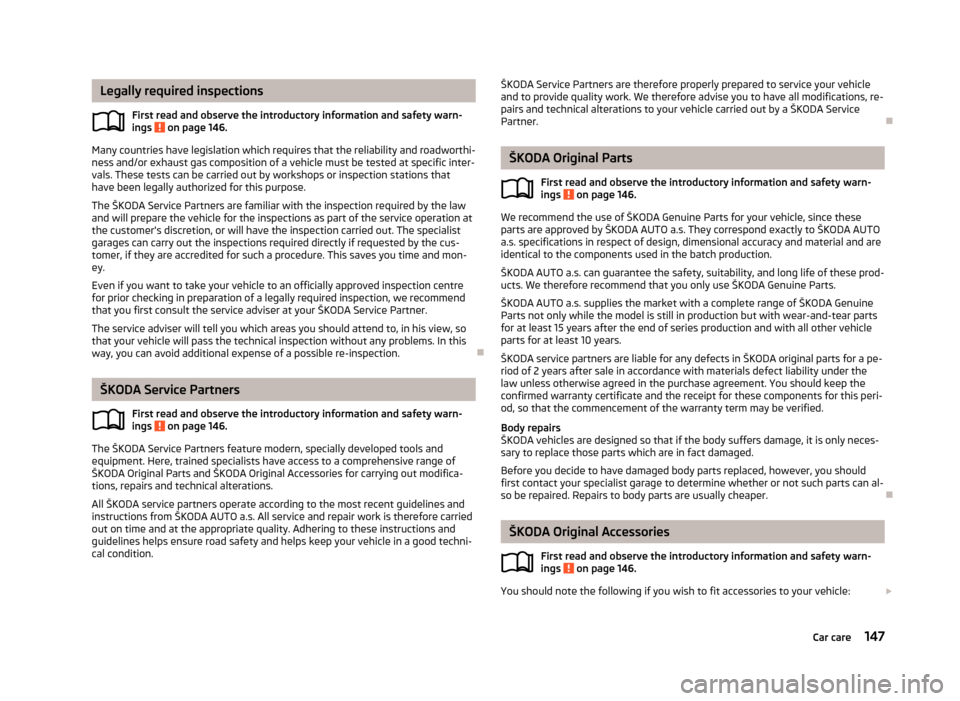
Legally required inspectionsFirst read and observe the introductory information and safety warn-
ings
on page 146.
Many countries have legislation which requires that the reliability and roadworthi-
ness and/or exhaust gas composition of a vehicle must be tested at specific inter- vals. These tests can be carried out by workshops or inspection stations thathave been legally authorized for this purpose.
The ŠKODA Service Partners are familiar with the inspection required by the lawand will prepare the vehicle for the inspections as part of the service operation at
the customer's discretion, or will have the inspection carried out. The specialist
garages can carry out the inspections required directly if requested by the cus-
tomer, if they are accredited for such a procedure. This saves you time and mon-
ey.
Even if you want to take your vehicle to an officially approved inspection centre
for prior checking in preparation of a legally required inspection, we recommend
that you first consult the service adviser at your ŠKODA Service Partner.
The service adviser will tell you which areas you should attend to, in his view, so
that your vehicle will pass the technical inspection without any problems. In this
way, you can avoid additional expense of a possible re-inspection.
ŠKODA Service Partners
First read and observe the introductory information and safety warn-ings
on page 146.
The ŠKODA Service Partners feature modern, specially developed tools and
equipment. Here, trained specialists have access to a comprehensive range of ŠKODA Original Parts and ŠKODA Original Accessories for carrying out modifica-tions, repairs and technical alterations.
All ŠKODA service partners operate according to the most recent guidelines and
instructions from ŠKODA AUTO a.s. All service and repair work is therefore carried
out on time and at the appropriate quality. Adhering to these instructions and guidelines helps ensure road safety and helps keep your vehicle in a good techni-
cal condition.
ŠKODA Service Partners are therefore properly prepared to service your vehicle
and to provide quality work. We therefore advise you to have all modifications, re-
pairs and technical alterations to your vehicle carried out by a ŠKODA Service
Partner.
ŠKODA Original Parts
First read and observe the introductory information and safety warn-
ings
on page 146.
We recommend the use of ŠKODA Genuine Parts for your vehicle, since these parts are approved by ŠKODA AUTO a.s. They correspond exactly to ŠKODA AUTO
a.s. specifications in respect of design, dimensional accuracy and material and are
identical to the components used in the batch production.
ŠKODA AUTO a.s. can guarantee the safety, suitability, and long life of these prod-
ucts. We therefore recommend that you only use ŠKODA Genuine Parts.
ŠKODA AUTO a.s. supplies the market with a complete range of ŠKODA Genuine
Parts not only while the model is still in production but with wear-and-tear parts
for at least 15 years after the end of series production and with all other vehicle parts for at least 10 years.
ŠKODA service partners are liable for any defects in ŠKODA original parts for a pe-
riod of 2 years after sale in accordance with materials defect liability under the
law unless otherwise agreed in the purchase agreement. You should keep the
confirmed warranty certificate and the receipt for these components for this peri- od, so that the commencement of the warranty term may be verified.
Body repairs
ŠKODA vehicles are designed so that if the body suffers damage, it is only neces-
sary to replace those parts which are in fact damaged.
Before you decide to have damaged body parts replaced, however, you should
first contact your specialist garage to determine whether or not such parts can al- so be repaired. Repairs to body parts are usually cheaper.
ŠKODA Original Accessories
First read and observe the introductory information and safety warn-ings
on page 146.
You should note the following if you wish to fit accessories to your vehicle:
147Car care